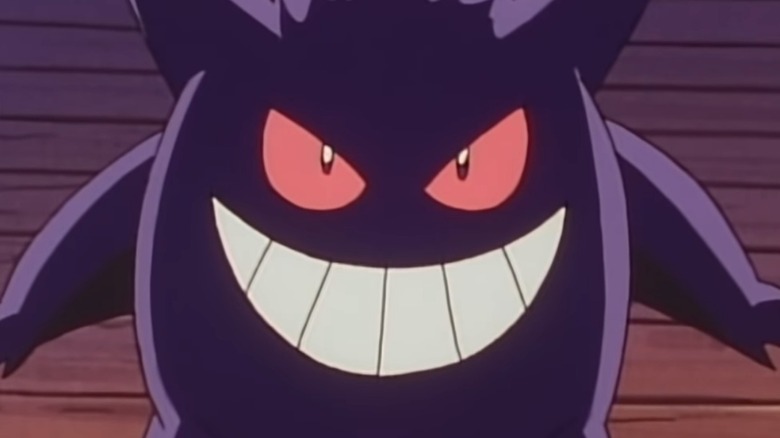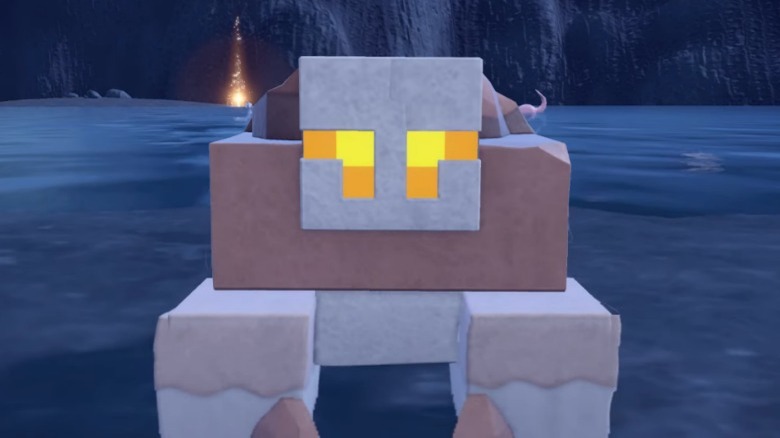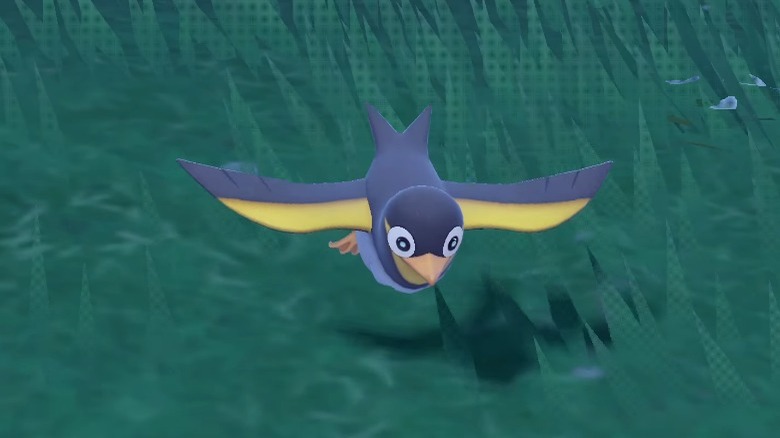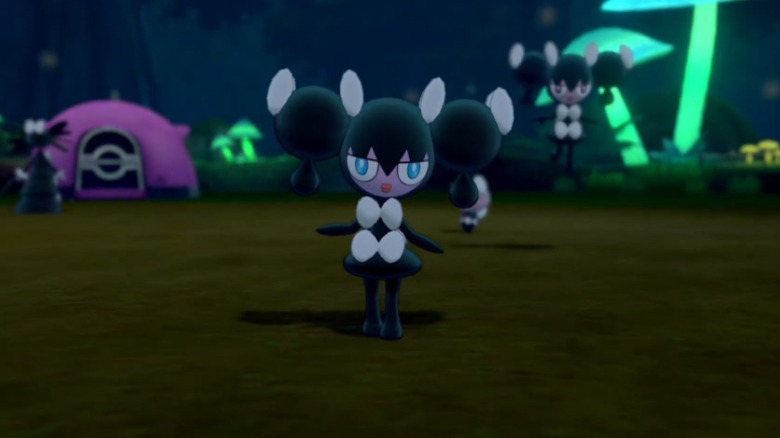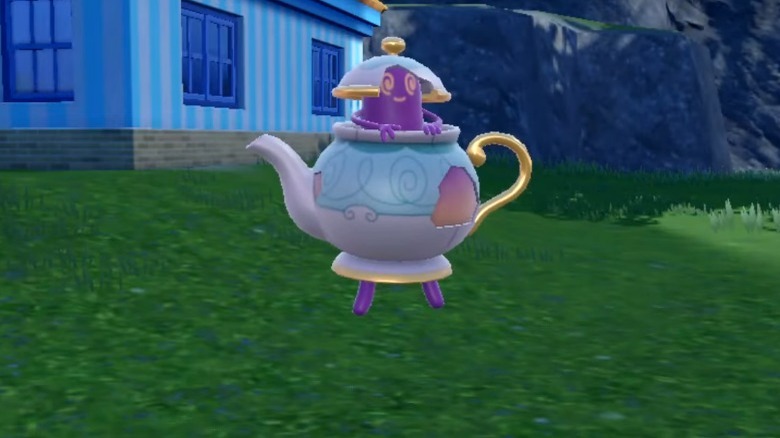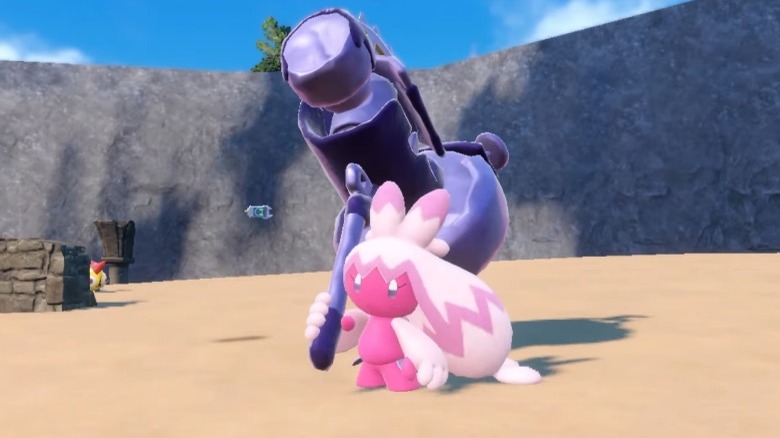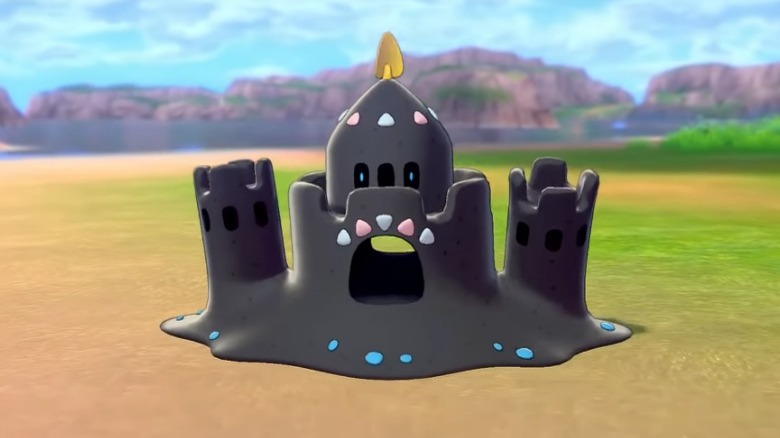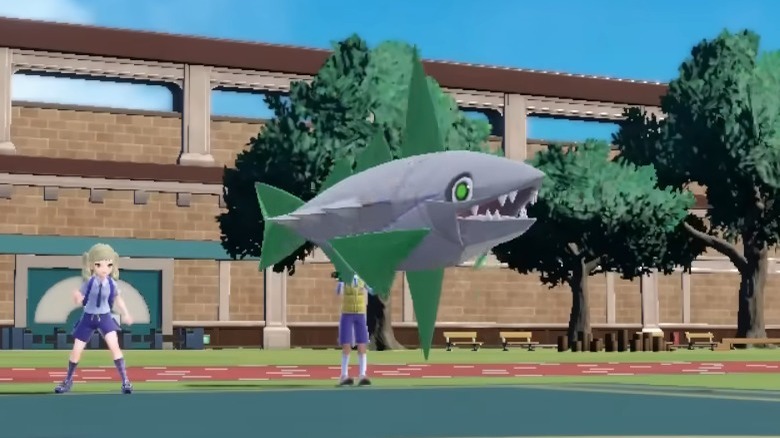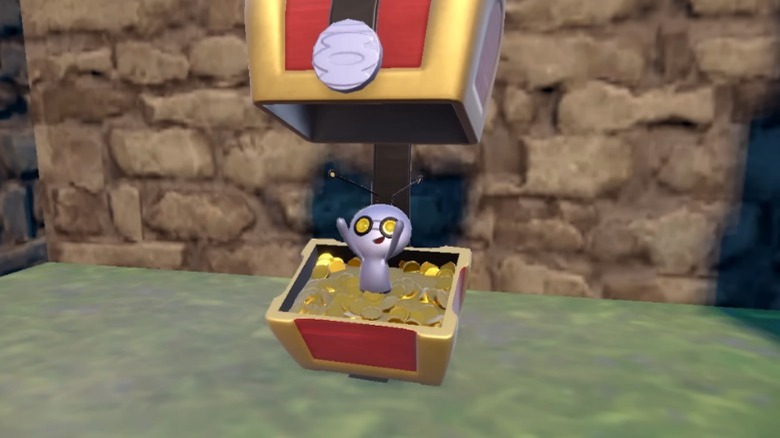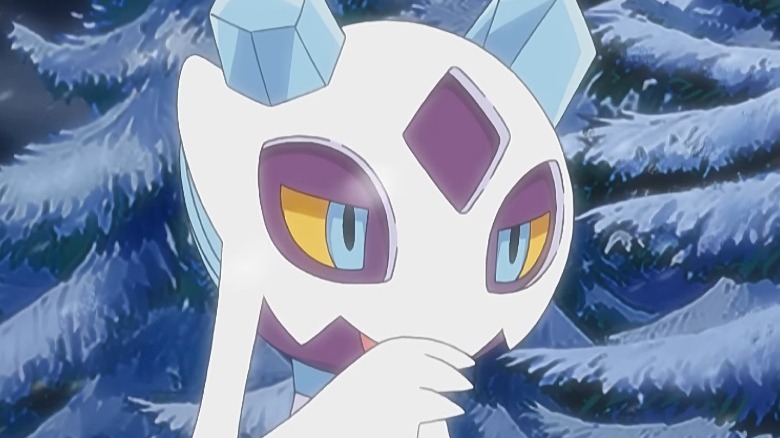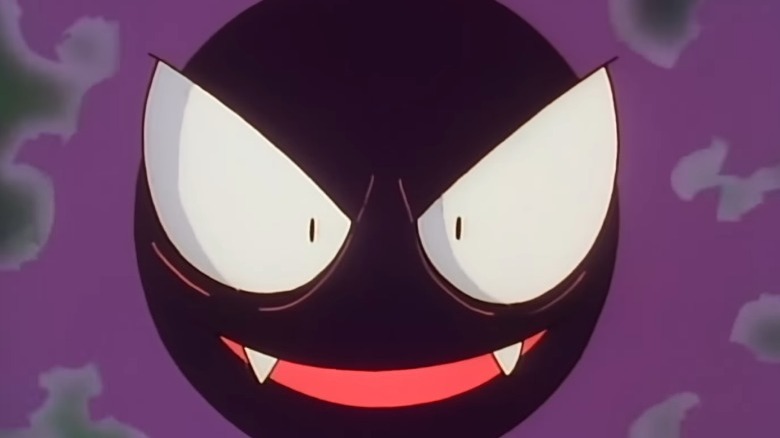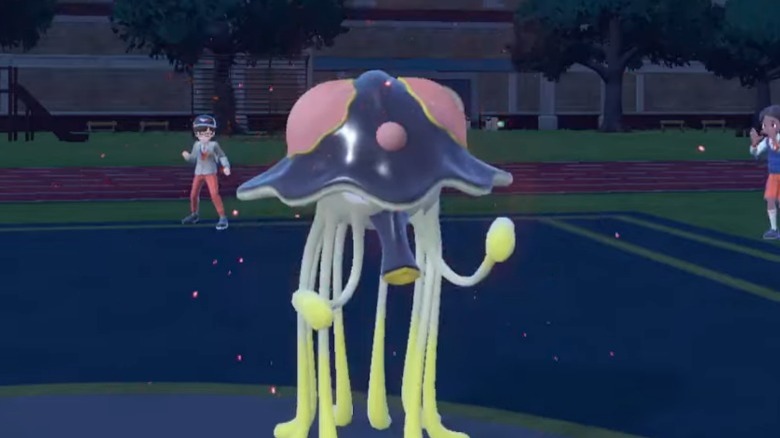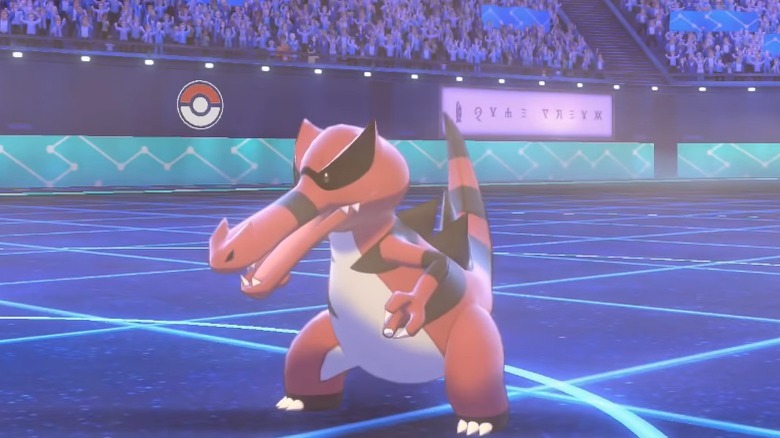The Most Disturbing Pokédex Entries In Pokémon Scarlet And Violet
"Pokémon" is a happy-go-lucky series about anime kids commanding a roster of colorful animals in friendly matches. Unless you read the Pokédex entries. Then the series transforms into a turn-based struggle for life and limb.
The main goal of every "Pokémon" game is to "catch 'em all." Each caught Pokémon adds to an in-game encyclopedia known as the Pokédex which provides tidbits of information about different creatures. Usually, these entries discuss their behaviors, abilities, and habitats, but occasionally these facts are downright disturbing.
Did you know that Sliggoo sometimes dissolve their friends because they are completely blind? Or that Bewear tend to accidentally snap their Trainers' spines by hugging them too tightly? You wouldn't unless you caught these Pokémon and read their Pokédex entries, and "Pokémon Scarlet" and "Violet" have their share of scary trivia regarding Pokémon biology.
Naclstack
The Rock-type Nacli and its evolutions are as blocky as rock salt and their names all contain NaCl, the chemical formula for salt (sodium chloride). In the real world, salt has many uses, such as preserving meat, and "Pokémon Scarlet" and "Violet" ask what would happen if wild animals could use this technique.
The second evolution of the Nacli line, Naclstack, which looks like it crawled out of "Minecraft," has learned how to weaponize its salt. According to the "Pokémon Scarlet" Pokédex, Naclstack "dry cures its prey by spraying salt over them" to remove water. On one hand, it's probably unhealthy for Naclstack to ingest water since they are made out of rock salt, but on the other hand, the process sounds very unpleasant.
If you look closely at the Pokédex entry, you might notice an important detail is missing: It doesn't state whether Naclstack prey are alive or dead. Preserving meat via salting is common in the real world, but since the Pokédex doesn't state Naclstack only salt the dead, it's neither difficult nor unrealistic to assume they dry cure living creatures. Imagine lying on the ground, unable to move as a Naclstack turns you into jerky. Then imagine the process lasting several weeks because that's just how long dry curing takes. Puts Naclstack in a much darker light, doesn't it?
Wattrel
Type advantages are some of the first lessons players learn in "Pokémon" games. The combat system is full of elemental types that interact with one another in a variety of ways, but what happens when a Pokemon uses these types outside of battle? In some cases, the answer is a localized genocide.
Wattrel is the latest in a long line of bird Pokémon. These petrel-like creatures can generate countless watts of electricity, hence the name, and they weaponize this ability to hunt. The "Pokémon Scarlet" Pokédex states that Wattrel "dives into the ocean, catching prey by electrocuting them." So, what's the big deal? Electric eels hunt by electrocuting prey after all. This may be true, but electric eels can't generate enough electricity to call down a smiting bolt of lightning. Wattrel, however, can.
Given Wattrel's electrical capacity, its Pokédex entry implies that each time a Wattrel dives into the water, it turns any nearby Water-types into fish fry. Not only is the process likely painful, especially for Mantyke (they're also part Flying-type, which makes them even more vulnerable), but it probably electrocutes Pokémon Wattrel didn't plan on eating. Because that's just how the cartoon logic of the "Pokémon" franchise works.
Gothorita/Gothitelle
Virtually every Pokémon trainer knows about Drowzee and their tendency to eat the dreams of children. This is creepy behavior, but at the end of the day, Drowzee just snack on the ephemeral fancies of kids' gray matter with no lasting damage. The same can't be said for other Pokémon.
The Gothita line is just plain weird. Each one looks like a stylized gothic lolita (even the males), but things don't get disturbing until its second stage, Gothorita. According to the "Pokémon Scarlet" Pokédex, these Pokémon "hypnotize children to put them to sleep before carrying them away" on starlit nights. Where do Gothorita take these children? Nobody knows, which makes the result even more disturbing. At least when Drifloon kidnap kids, we know they probably transport them to the afterlife, and even then, Drifloon only do so by accident. Gothorita's reasons for abduction are as mysterious as the final destination.
One might argue that Gothita's last evolution, Gothitelle, is creepier than Gothorita since "Pokémon Violet" states they have "seen the end of all existence." But the creature's "Pokémon Scarlet" Pokédex entry counters that Gothitelle are known to share these visions, and that those who have seen them claim they are "ethereal and beautiful." Not quite as disturbing as spiriting away a kid, never to be seen again.
Sinistea/Polteageist
In the real world, some people enjoy dining on the fugu puffer fish. This dish is reportedly delicious, but anyone who eats it is essentially playing Russian roulette with a fork because when not properly prepared, Fugu flesh contains lethal amounts of a potent neurotoxin. Gambling one's life to eat a meal seems foolhardy, but not quite as foolhardy as drinking Sinistea and Polteageist.
Sinistea and its evolution, Polteageist, are sentient cups and kettles of tea, and like any self-respecting Ghost-type, they specialize in killing unsuspecting victims in sinistea...er, sinister ways. Sinistea's "Pokémon Scarlet" Pokédex entry plainly states that once ingested, they parasitize whoever drank them. And according to "Pokémon Scarlet," "drinking too much [Polteageist] can be fatal." But that's just the surface.
It's difficult to tell if Sinistea is more disturbing than Polteageist or vice versa. According to their respective entries, Sinstea advertise their deadly nature with a horrible flavor. In contrast, Polteageist are actually delicious, which invites people to imbibe fatal amounts. Their respective "Pokémon Violet" and "Scarlet" Pokédex entries also state that some people do whatever they can to make these Pokémon possess their tea. By comparison, courting death via fugu is understandable since only its organs contain the neurotoxin. Meanwhile, Sinstea and Polteageist might not be Poison-types, but they are still toxic by their very nature.
Tinkatuff/Tinkaton
What's the difference between "Pokémon" and "Monster Hunter"? One is a series about capturing wild animals to use in organized fights, another is a series about killing wild animals and using their body parts to hunt even bigger and more dangerous creatures. At least, that used to be the case.
Audiences have fawned over the new Tinkatink line, and what's not to love? They're tiny and pink, sport dual Fairy/Steel-typing, and can learn the most powerful Steel-type attack in the series that isn't a Z-Move. However, the source of this Pokémon and its evolutions' power comes at the cost of endemic Paldean life. While Tinkatink forge their hammers out of scrap metal, its evolution, Tinkatuff, hunts Pawniard and Bisharp and uses their metal to craft hammers (according to "Pokémon Scarlet"). Since Pawniard and Bisharp are part Steel-type and generally don't carry items, the implication is clear: Tinkatuff hammers are made out of Pawniard and Bisharp body parts.
This behavior continues into Tinkatink's final evolution, Tinkaton. Its "Pokémon Scarlet" Pokédex entry explains that Tinkaton like to knock Corviknight out of the sky by launching rocks at them, sort of like the world's deadliest round of golf. This isn't just sociopathic behavior, though; Corviknight's Pokédex entry refers to Corviknight's "natural predators," which implies Tinkaton hunt the Steel/Flying-type Pokémon and use their metal bodies to craft 220 lb. hammers.
Palossand
Predators are not uncommon in the world of "Pokémon," and like real-world predators, most kill their prey as quickly as possible. But every now and then you encounter a Pokémon that eats their food nice and slow — well, it's not "nice" for their victims.
"Pokémon Sun" and "Moon" introduced the Sandygast line, which are physically little more than sentient sand castles. Since day one, audiences knew these Pokémon were insidious because they can control people to add sand to their bodies, but "Pokémon Scarlet" and "Violet" add to the creepy factor. According to the "Pokémon Scarlet" Pokédex entry for Sandygast evolution Palossand, these Pokémon bury prey deep inside their "sandy [bodies]" and suck their life out, but not all at once. No, Palossand use their prisoners as pick-me-ups whenever they want, which is pretty disturbing. The only thing worse than being trapped in living sand is being trapped in living sand that sucks your blood over a prolonged period of time.
You might assume that once a Palossand's victim is all used up, it's done with them, but the Pokémon isn't that kind. Palossand's "Pokémon Violet" entry states that during combat, they use "the bones of [their] victims" as projectiles. We don't even have to explain how gruesome it is to see a living sand castle shoot brittle, dried-up bones out of its arms like a makeshift gatling gun.
Veluza
Pokémon are capable of a variety of feats, many of which aid them in combat. But some are as unnecessary as they are disgusting.
Veluza is one of the newest fish-like Pokémon in "Pokémon Scarlet" and "Violet," and while they look somewhat plain, they have the disturbing ability to strip away their own flesh. That is not hyperbole. Veluza's signature ability is "Fillet Away," which sacrifices health to improve its Attack, Special Attack, and Speed. Moreover, the Pokédex entries of both "Pokémon Scarlet" and "Violet" state Veluza strip away "unnecessary" and "spare flesh" to hone their stats.
Despite what the Pokédex calls these discarded parts of Veluza's body, the Pokémon still willingly trade half of their health to improve battle prowess. Judging by the model, when Veluza uses Fillet Away, they whittle themselves down to the spine. Discarding that much flesh is bound to be painful, especially since it apparently removes all of the creature's vital organs. Or is everything stored in the head? Regardless, this is still disturbing to think about.
Gimmighoul
In real life, some animals mimic other animals. The milk snake is one of the most famous examples since it copies the colors of the deadly coral snake, albeit not their pattern. The world of Pokémon is full of similar acts of mimicry, but instead of copying other creatures, many tend to parrot man-made objects to lure humans in to devastating results.
Gimmighoul is the latest in a long line of mimic Pokémon that stretches all the way back to Gen 1 and its Voltorbs. Gimmighoul comes in two varieties: Chest Form and Roaming Form. Both feed off the greed of mankind. According to "Pokémon Scarlet," Chest Form Gimmighoul steal the life of thieves who try to snatch coins from their chest-shaped body, but the Roaming Form's "Pokémon Violet" Pokédex entry reveals that the creature is a lot less picky and will eat the essence of anyone who touches its coin.
The Chest Form's entry is essentially a parable: Someone steals a treasure and pays for it. That's basically the premise of each installment in the horror comedy franchise "Leprechaun." But Gimmighoul's Roaming Form doesn't discriminate. Anyone who "[tries] to pick up its coin," be they a scoundrel or an innocent kid, gets their soul sucked. It's almost enough to make you think twice about the childhood rhyme, "Find a penny, pick it up. All day long, you'll have good luck."
Froslass
When Pokémon use their elemental abilities outside of combat, they usually have a good (or at least understandable) reason. Cubchoo, for instance, accidentally gives humans a nasty case of frostbite merely by sneezing on them, while its evolution, Beartic, literally puts other Pokémon on ice to preserve them and eat later. When Froslass use their powers outside of combat, though, it's nothing short of a show of psychopathy.
Froslass was introduced in "Pokémon Diamond" and "Pearl" as an alternate, gender-locked evolution of Snorunt; only female Snorunt can turn into Froslass, and only if given a Dawn Stone. Ever since, Froslass have been portrayed as spectral stalkers deserving of their Ghost-typing. According to the Pokédex in "Pokémon Violet," Froslass freeze their prey and then display them. Display them where? What is its prey? "Pokémon Scarlet" expands on this entry and clarifies that Froslass hunt "humans or Pokémon [they like]" and then turn them into frozen decorations in their homes.
Being transformed into an ice sculpture is a gruesome fate since, unlike taxidermists, Froslass don't have the common courtesy to wait until their decorations are dead before preserving them. Plus, anyone who can't break out of the ice likely either freezes to death or suffocates. Not good odds.
Gastly/Gengar
Ghost-types are some of the scariest creatures in the Pokémon world; this kind of comes with the territory of that classification. While the series has added plenty of new Ghost-types over the years, the originals still outdo many newcomers.
Gastly and its evolutions, Haunter and Gengar, are as gaseous as other Ghost-type Pokémon, but they are arguably more dangerous because they are also Poison-types. No other Pokémon uses this combination. According to its "Pokémon Violet" Pokédex entry, Gastly can wrap their bodies around someone and suffocate them. But even if the victim holds their breath for a long time (or breathes through a scuba oxygen tank), they aren't safe. According to "Pokémon Scarlet," these same Gastly gasses poison people just by touching their skin. Death via simultaneous suffocation and poisoning is pretty inevitable.
As disturbing as Gastly's hunting method is, Gengar's is arguably creepier. While Gastly viciously wrap around their victims, Gengar are opportunistic stalkers. Its Pokédex entry in both "Pokémon Scarlet" and "Violet" explains that they hunt by hiding in targets' shadows. You can hide from a Gastly, but you can't hide from your own shadow. Even worse, Gengar apparently sap the heat from their victims, so anyone who feels a shiver down their spine when they believe they're by their lonesome might not be as alone — or safe — as they think.
Toedscruel
"Pokémon Sun" and "Moon" introduced the concept of regional variants: Pokémon of the same species adopting different appearances and typings depending on their habitat. "Pokémon Scarlet" and "Violet" took that idea one step further with convergent evolution, i.e., unrelated species developing forms similar to one another. While Wiglett and Wugtrio are the most famous examples, they aren't the only Paldean Pokémon to look like older creatures.
Toedscool and its evolution, Toedscruel, are extremely weird Pokémon. They might resemble Tentacool and Tentacruel, but they're mushrooms, not jellyfish. And, even though Toedscruel look funny when they walk on their tentacle...feet...things, they have the same nasty disposition as their Kantonian namesakes. According to the "Pokémon Violet" Pokédex, Toedscruel slowly and painfully "suck out their [prey's] nutrients."
Toedscruel keep their food alive while they slurp up the vital juices, and they don't care how much pain they cause. Toedscruel truly earn their "cruel" moniker, but the Pokédex isn't done. Apparently, the folds on Toedscruel heads are delicious. Normally, we would question why the Toesdcruel Pokédex entry ends on that piece of mood whiplash, but what if they're connected? What if Toedscruel are so delicious because of their predatory diets? When people eat Toedscruel head folds, are they technically eating their victims? Food for thought.
Krookodile
Though many Pokémon draw inspiration from the real world animal kingdom, these ideas usually only copy physical forms. Donphan may roll around like wheels but elephants can't, and when was the last time anyone saw a cobra sneeze out sand like a Silicobra? Krookodile is one of the few disturbing exceptions.
The Sandile line is obviously inspired by crocodiles and is known for its special eyes, but the final evolution, Krookodile, is infamous for their jaws. Many Pokédex entries state Krookodile can snap cars in half, but "Pokémon Scarlet" adds a disturbing wrinkle to their tactics. According to that game, not only do Krookodile clamp down on prey, but the Pokémon "twists its body around to rip its prey in half."
Quick and disturbing zoology lesson: Krookodile's hunting technique is a one-to-one translation of the death roll. In the real world, crocodiles and alligators grab onto prey with their jaws and twist around to wrench limbs off still-living animals. Picture how you twist off a cooked chicken's legs or wings. Now imagine that chicken was still alive and kicking, figuratively and literally. You should have a good idea of what the Pokédex says Krookodile do to prey. Not a pretty sight.

